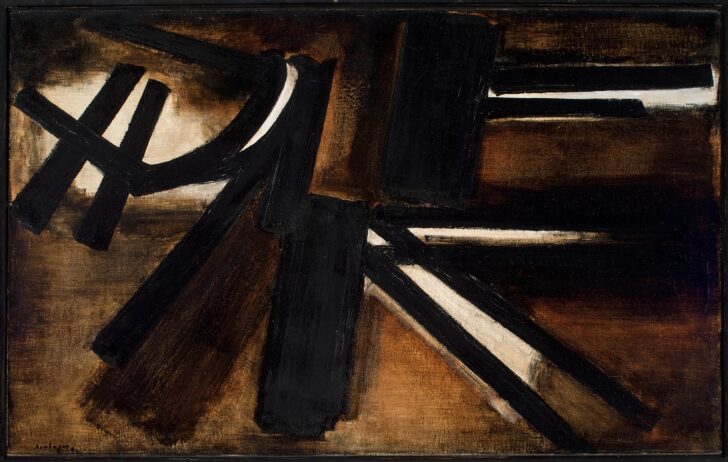20 décembre 1952
Pierre Soulages

Description
March 28, 2009
Both a color and a non-color, when light is reflected on black, it transforms and transmutes it. It opens up a mental field all of its own.
—Pierre Soulages
Known as “the painter of black,” Soulages began experimenting with abstraction in 1947. Influenced by early impressions of austere Romanesque architecture, Celtic monuments, and Chinese calligraphy, he began using thick, heavy, bar-like brushstrokes of black against a contrasting light background. At the time, the preponderance of dark tones in his works was in striking contrast to the vibrant use of color in most French painting.
In this work Soulages offers no clues to his subject. The title of the work, which characteristically refers to the date of its completion, provides the viewer with little context or meaning. This is meant to focus attention on the balance of darkness and light, volume and void, process and gesture. Although the bold and gestural quality of the painting are reminiscent of the work of Abstract Expressionist artists like Franz Kline, Soulages worked very differently: he did not rely on improvisation, but carefully built up the layers of his paintings over a period of several months.
Subject Matter:
Soulages is considered to be the one of the most important painters in 20th century French art. His use of bold, gestural strokes, in works such as this, resulted in comparisons to Abstract Expressionism. However, Soulages’ work, while appearing spontaneous, is actually the culmination of concentrated and deliberate layering, often over a period of several months. He is known for experimenting greatly with the properties of the color black which the artist does not believe exists in the absolute. Rather, here, he has placed the darker tones against lighter backgrounds to represent how the color makes the strongest contrast to illuminate ground. This likewise emphasizes Soulages' interest in the formal quality of art, much more so than its representational abilities. Adding to his lack of regard for a distinct need for representation or meaning in his work, the title of the work refers simply to the painting's creation date.
Physical Description:
Abstract painting in muted colors with shades of blacks, browns, and white. The composition consists of bold diagonal lines and blocks of black, brown, and white.
Usage Rights:
If you are interested in using an image for a publication, please visit https://umma.umich.edu/request-image/ for more information and to fill out the online Image Rights and Reproductions Request Form.